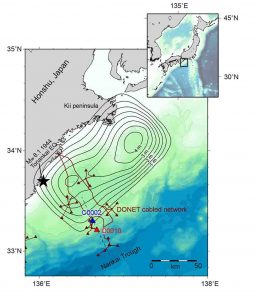
Understanding slow-slip earthquakes in subduction zone areas may help researchers understand large earthquakes and the creation of tsunamis, according to an international team of researchers that used data from instruments placed on the seafloor and in boreholes east of the Japanese coast.
“This area is the shallowest part of the plate boundary system,” said Demian Saffer, professor of geosciences, Penn State. “If this region near the ocean trench slips in an earthquake, it has the potential to generate a large tsunami.”
Two tectonic plates meet here, the Pacific Plate and the Eurasian Plate, in a subduction zone where the Pacific plate slides beneath the Eurasian plate. This type of earthquake zone forms the “ring of fire” that surrounds the Pacific Ocean, because once the end of the plate that is subducting — sliding underneath — reaches the proper depth, it triggers melting and forms volcanoes. Mt. St. Helens in the American Cascade Mountains is one of these volcanoes, as is Mt. Fuji, about 60 miles southwest of Tokyo. Subduction zones are often also associated with large earthquakes.
The researchers focused their study on slow earthquakes, slip events that happen over days or weeks. Recent research by other groups has shown that these slow earthquakes are an important part of the overall patterns of fault slip and earthquake occurrence at the tectonic plate boundaries and can explain where some of the energy built up on a fault or in a subduction zone goes.
“These valuable results are important for understanding the risk of a tsunami,” says James Allan, program director in the National Science Foundation’s Division of Ocean Sciences, which supports IODP. “Such tidal waves can affect the lives of hundreds of thousands of people and result in billions of dollars in damages, as happened in Southeast Asia in 2004. The research underscores the importance of scientific drillship-based studies, and of collecting oceanographic and geologic data over long periods of time.”
In 2009 and 2010, the IODP (Integrated Ocean Drilling Program, now the International Ocean Discovery Program) NanTroSEIZE project drilled two boreholes in the Nankai Trough offshore southwest of Honshu, Japan, and in 2010 researchers installed monitoring instruments in the holes that are part of a network including sensors on the seafloor. Saffer and Eiichiro Araki, senior research scientist, Japan Agency for Marine-Earth Science and Technology, co-lead authors, published their results today (June 16) in Science. The two boreholes were 6.6 miles apart, straddling the shallow boundary of slip in the last major earthquake in this area, which occurred in 1944 and measured magnitude 8.1. The accompanying tsunami that hit Tokyo was 26 feet in height.
“Until we had these data, no one knew if zero percent or a hundred percent of the energy in the shallow subduction zone was dissipated by slow earthquakes,” said Saffer. “We have found that somewhere around 50 percent of the energy is released in slow earthquakes. The other 50 percent could be taken up in permanent shortening of the upper plate or be stored for the next 100- or 150-year earthquake. We still don’t know which is the case, but it makes a big difference for tsunami hazards. The slow slip could reduce tsunami risk by periodically relieving stress, but it is probably more complicated than just acting as a shock absorber.”
The researchers found a series of slow slip events on the plate interface seaward of recurring magnitude 8 earthquake areas east of Japan. These slow earthquakes lasted days to weeks, some triggered by other unconnected earthquakes in the area and some happening spontaneously. According to the researchers, this family of slow earthquakes occurred every 12 to 18 months.
“The area where these slow earthquakes take place is uncompacted, which is why it has been thought that these shallow areas near the trench act like a shock absorber, stopping deeper earthquakes from reaching the surface,” said Saffer. “Instead we have discovered slow earthquakes of magnitude 5 or 6 in the region that last from days to weeks.”
These earthquakes typically go unnoticed because they are so slow and very far offshore.
The researchers also note that because earthquakes that occur at a distance from this subduction zone, without any direct connection, can trigger the slow earthquakes, the area is much more sensitive than previously thought. The slow earthquakes are triggered by the shaking, not by any direct strain on the area.
“The question now is whether it releases stress when these slow earthquakes occur,” said Saffer. “Some caution is required in simply concluding that the slow events reduce hazard, because our results also show the outer part of the subduction area can store strain. Furthermore, are the slow earthquakes doing anything to load deeper parts of the area that do cause big earthquakes? We don’t know.”
Note: The above post is reprinted from materials provided by Penn State.










